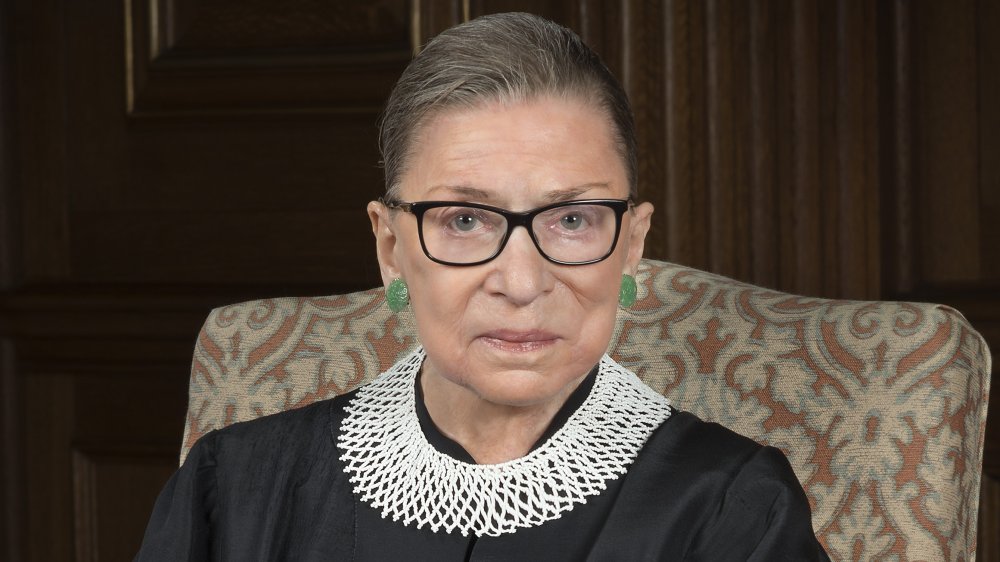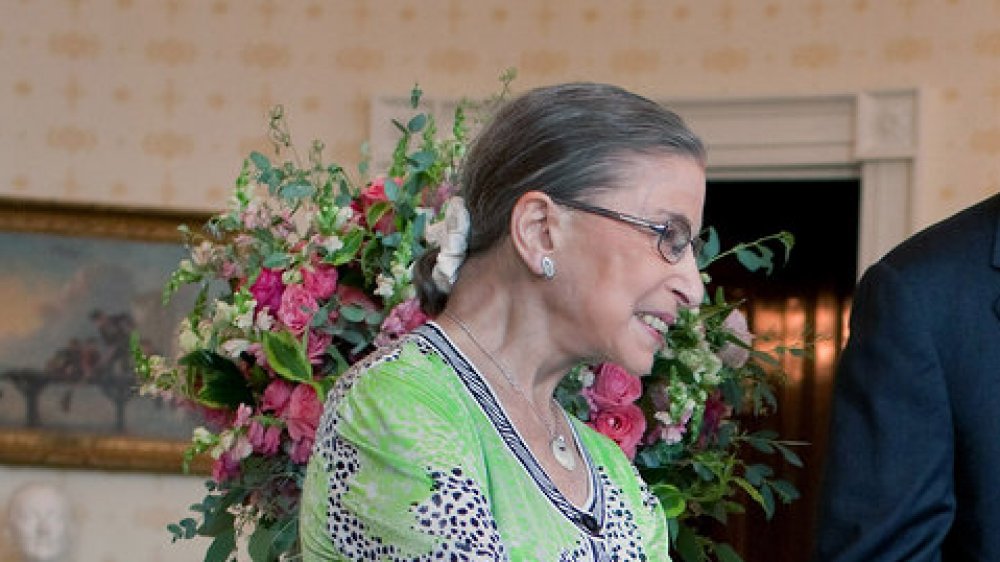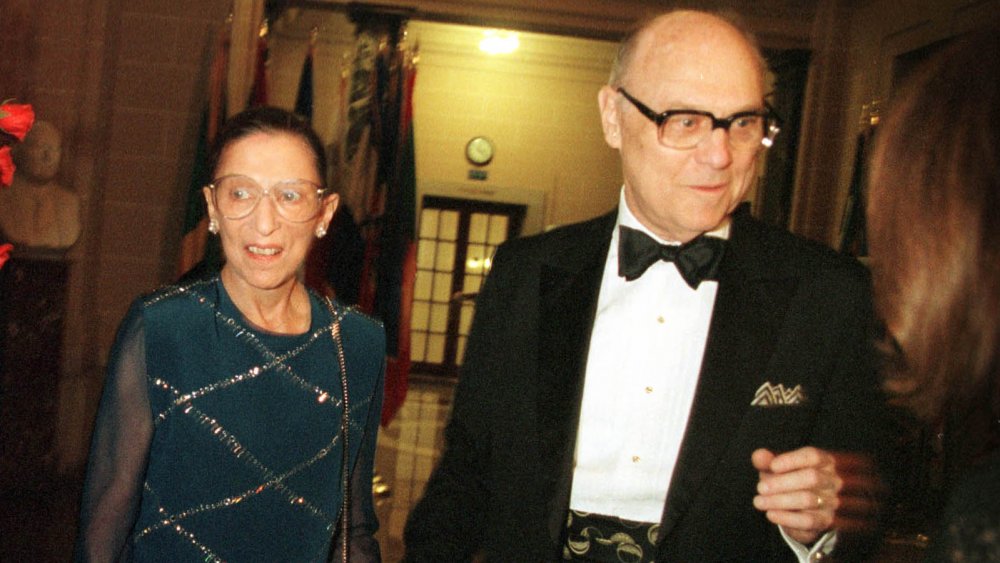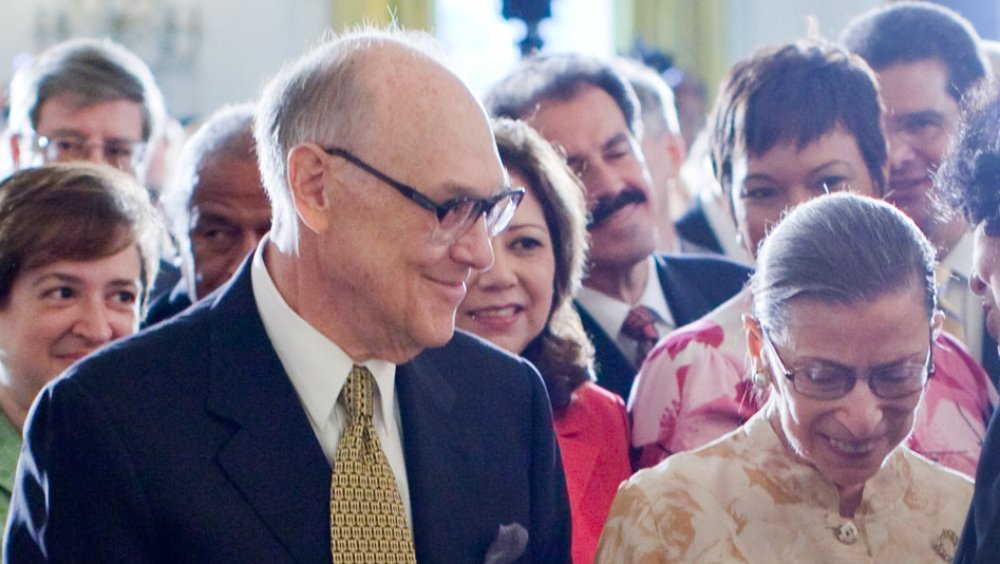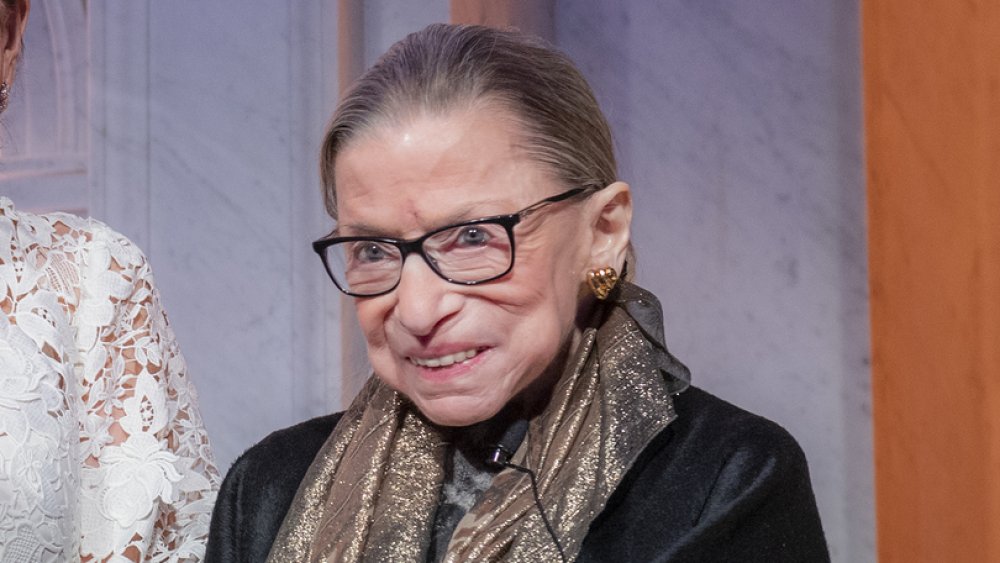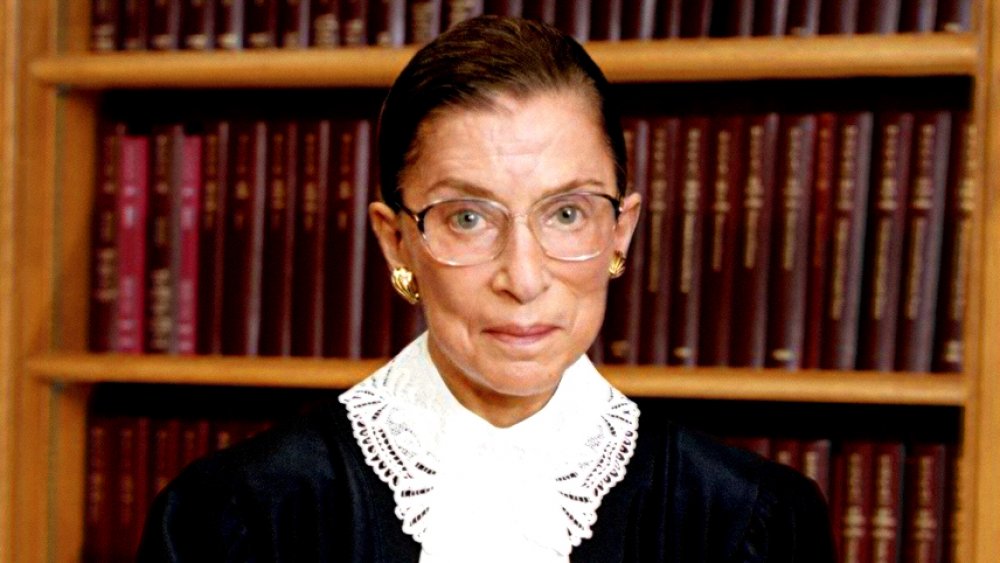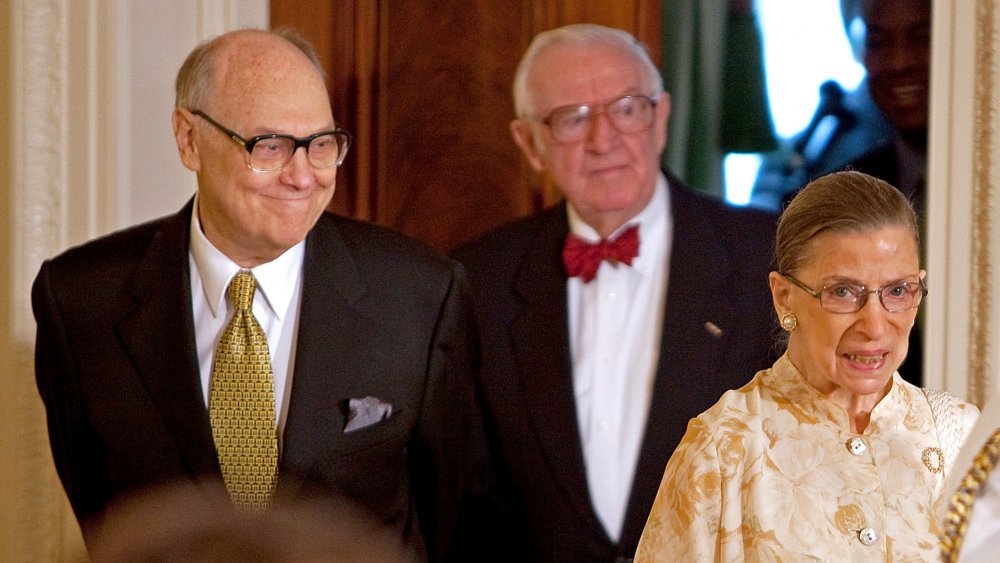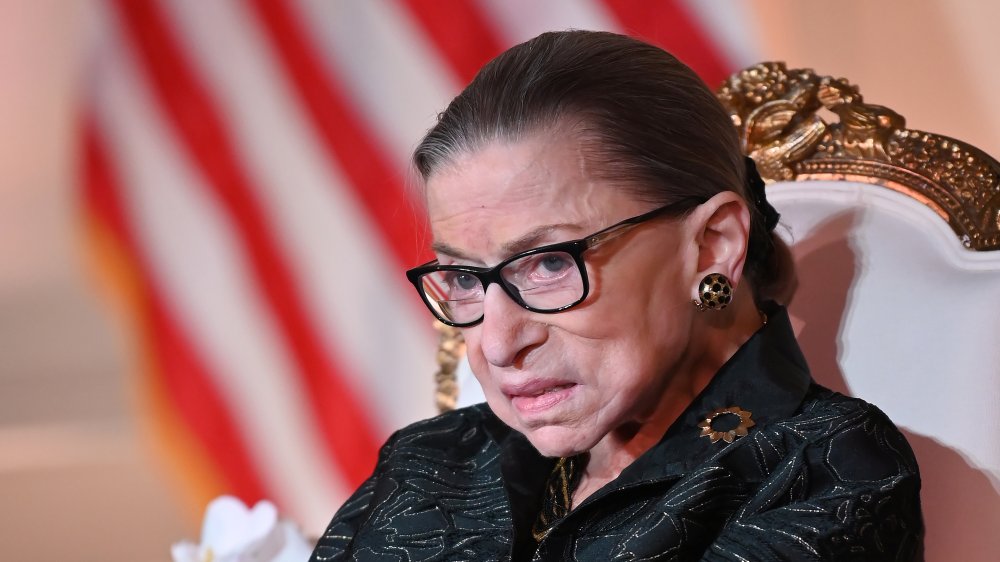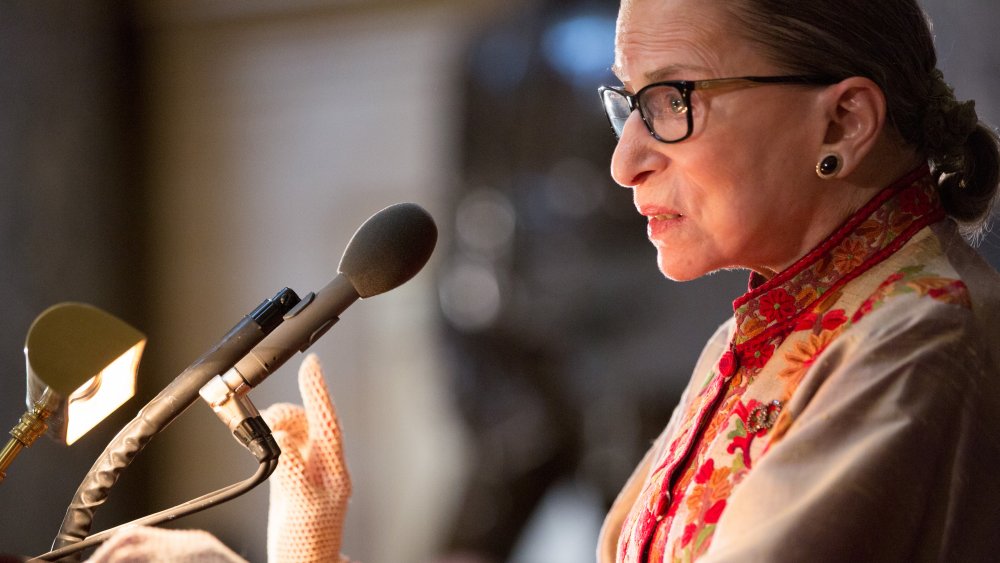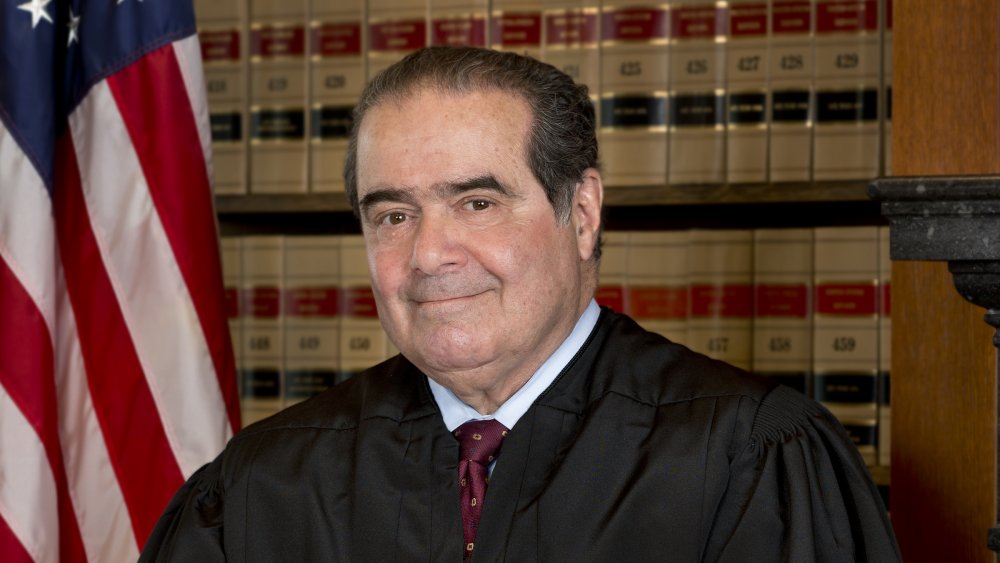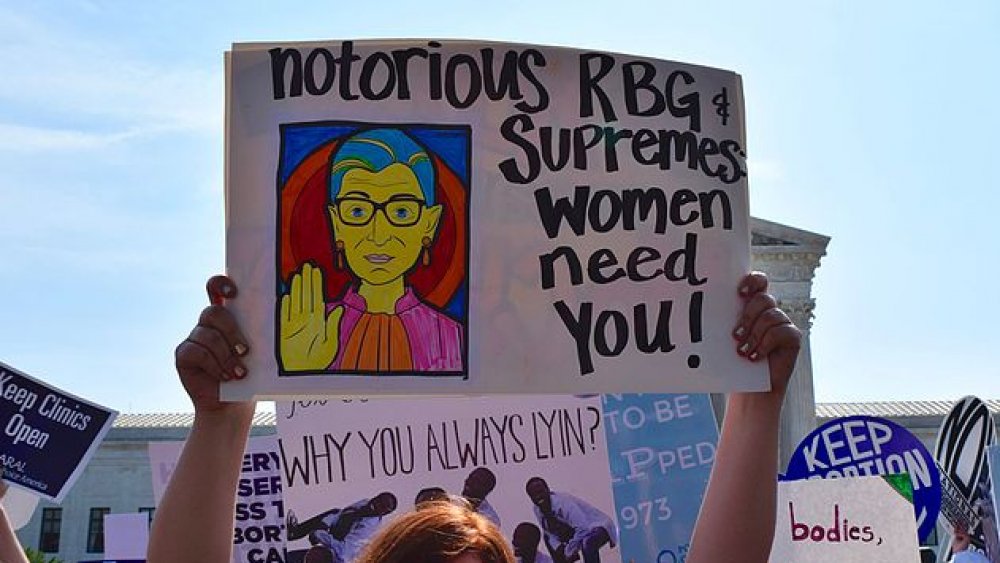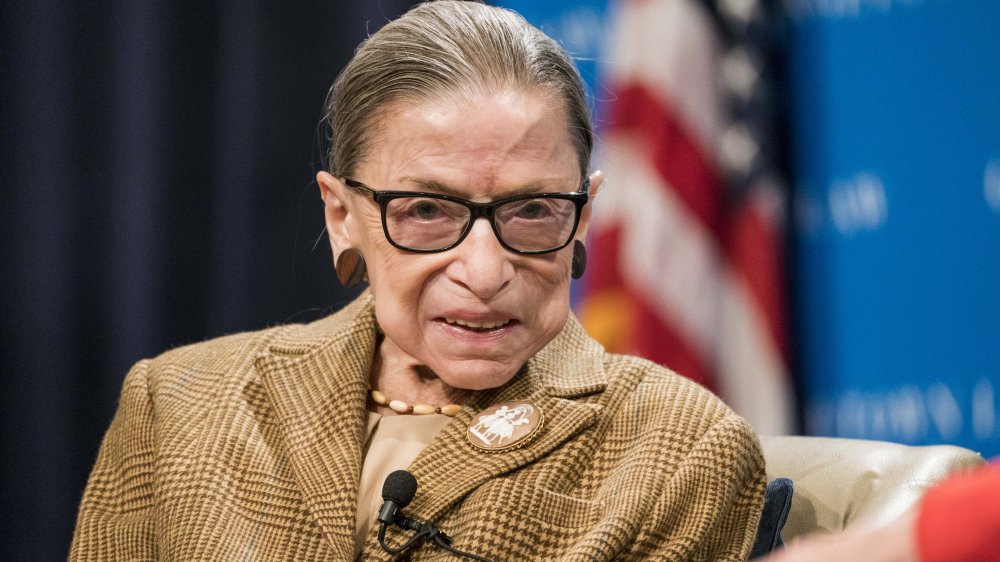The Tragic Real-Life Story Of Ruth Bader Ginsburg
It's not often that Supreme Court Justices become so famous that people other than law nerds know their names, let alone their faces, workout routines, and their most witty dissenting lines. But Ruth Bader Ginsburg's reputation escaped the dull confines of complicated legal procedure and made it all the way to Saturday Night Live, a biopic starring Felicity Jones as the Justice, and maybe even the coffee mug you're drinking from right now.
Before she put on her judge's robes — and her dissenting collar — Ginsburg made a name for herself as the most famous (but not the only) lawyer fighting the war of attrition for women's rights. She was a founder and president of the ACLU's Women's Rights Project in 1972, and contributed to significant Supreme Court decisions that ruled against laws that discriminated on, as Ginsburg argued, the basis of sex. Just over two decades later, in 1993, she became the second female Supreme Court Justice in history (Sandra Day O'Connor was the first, in 1981.)
Finally, Ruth Bader Ginsburg died of cancer complications on September 18, 2020, according to a statement from the Supreme Court. Ginsburg's success didn't come easy. She overcame all kinds of things to make her mark on the country and its judicial landscape. Here's the tragic story of Ruth Bader Ginsburg.
Ruth Bader Ginsburg's mother died when she was a teenager
In case you were wondering who to thank for Ruth Bader Ginsburg's meticulous approach to her judicial duties, her encyclopedic knowledge, and her resilience, Ginsburg credited her mother Celia. "She armed me with the strength to persist, even if I am not successful, and never to give up, to keep trying," Ginsburg told CNN. Despite being, in Ginsburg's words, "perhaps the most intelligent person I knew," Celia wasn't allowed to pursue higher education, because she was a woman. Instead, she worked in a garment factory to help fund her brothers' college degrees.
Unusually for American mothers in the 1950s, Celia's main message to her daughter was not to marry well, but to take her own education and career seriously. "Fend for yourself, was her message: be independent," Ginsburg told CNN. Celia instilled a love of reading in her daughter, and laid the groundwork for her work as a campaigner for women's right: she had marched in the Suffrage parades to earn the right to vote.
Sadly, Celia didn't live to witness her daughter's remarkable accomplishments. She died of cancer when Ginsburg was 17, the day before her high school graduation ceremony. As a baby, Ginsburg had also lost her older sister, Marilyn, who was just 6, to meningitis.
Ruth Bader Ginsburg endured sexism at law school and beyond
Having come top of her class in Cornell in 1954 — on a full scholarship — Ruth Bader Ginsburg was accepted to Harvard Law School. She had to wait to attend, since her new husband Marty had been drafted into the US Army. The couple was posted to Fort Sill, Oklahoma, for two years.
In 1956, along with their 14-month-old daughter Jane, Marty returned to Harvard Law School and Ruth took up her studies. She was one of only nine women in a class of 500 students: women had only been accepted to the law school starting in 1950. They weren't allowed to use the library and were not called upon in class. At one point, a dean asked the nine women to explain why they were taking up a place that could have gone to a man.
The discrimination continued after Ginsburg graduated joint top of her class in 1959, having transferred to Columbia. She couldn't find any New York law firm that was willing to hire her. And when she was given a job as an assistant professor at Rutgers School of Law in 1963, she was offered less money because of Marty's salary.
Ruth Bader Ginsburg's husband Marty had a cancer scare when he was very young
Ruth Bader Ginsburg and her husband Marty Ginsburg met when she was a freshman and he was a sophomore at Cornell. Marty had asked a friend to set up a date based on Ruth's looks, but he was quickly smitten by her intelligence. Ruth later remarked, "He was the first boy I ever knew who cared that I had a brain." The two married in June 1954, days after Ruth's graduation. The marriage helpfully made her family more accepting of her law school ambitions: at least she had a fallback if the whole lawyer thing didn't work out.
The couple's biggest test came during Marty's last year of law school, and Ruth's second. The Hollywood Reporters says he was diagnosed with potentially fatal testicular cancer. Marty underwent surgery, and then six weeks of daily radiation that made him exhausted and sick, but ultimately saved his life. Ruth looked after him and their young daughter Jane, while also keeping up with her law school work, copying notes for Marty's classes from his friends, and serving on the prestigious Harvard Law Review. Their son James later described this period as, "the crisis that turned RBG into the superwoman" she became.
Marty Ginsburg was a truly exceptional husband
In the 1950s and '60s, most wives of high-flying New York tax attorneys were expected to support their husbands' careers by managing the household and childcare and looking nice at cocktail parties. But Marty not only encouraged Ruth to pursue her law career, he took on the domestic duties so she could keep rising through the ranks. (This was only partly inspired by her inability to cook.)
In the early stages of Marty's career, Ruth had transferred from Harvard to Columbia so he could work his way up to becoming a partner in a New York law firm, and had taken on the majority of the childcare. But in 1972, when she became Columbia Law School's first tenured female professor and founded the ACLU Women's Rights Project, Marty took the reigns at home. (And, according to the Hollywood Reporter, affectionately banished her from the kitchen.)
When Ruth was named to the D.C. Court of Appeals in 1980, Marty shocked everyone by giving up his own tenureship at Columbia Law School and his law firm to move from New York to D.C. And in 1993, Marty launched his own private campaign to get Ruth posted to the Supreme Court, convincing scholars to write to indecisive President Clinton on her behalf. It worked.
Ruth Bader Ginsburg led the fight against sex discrimination
The seeds of Ruth Bader Ginsburg's pre-Supreme Court career as the nation's most famous feminist legal crusader began in the early '60s. But it was in 1971, as a tenured professor at Rutgers' School of Law, that she shifted her legal focus to gender discrimination.
Ginsburg partnered with the New Jersey branch of the ACLU, which had been receiving more complaints about gender discrimination in the wake of the 1963 Equal Pay Act. After taking on and winning smaller cases for a while, in 1971 Ruth and Marty argued Moritz v. Commissioner of Internal Revenue before the Tenth Circuit Court of Appeals. That year, she also wrote the brief for Reed v. Reed, which proved to be the first time the Supreme Court ruled against a law because it discriminated based on sex. As director of the ACLU's Women's Rights Project, Ruth argued over 300 gender discrimination cases, and contributed to six at the Supreme Court.
However, Ruth later pointed out that she was not the first or only woman fighting for gender equality in the courts. She named lawyers and civil rights activists Pauli Murray and Dorothy Kenyon as co-authors in her brief for Reed, acknowledging the foundations they laid for her work.
Ruth Bader Ginsburg was an unapologetic workaholic
You don't get to make history without working hard, and Ruth Bader Ginsburg always had a strong work ethic. She was known for working very late hours — sometimes until 2 or 3 am — and for writing her majority opinions in an average of 60 days, nearly a month faster than her eight fellow Justices. In 2016, she explained to CBS, "I stay up as long as is necessary for me to feel comfortable that I have a solid grasp on the case." She added that she could get by on two to four hours of sleep a night — something her son James thinks she learned while looking after cancer-stricken Marty and their daughter Jane during law school.
Work also provided a welcome distraction during Ginsburg's own health issues. A few months after being successfully treated for lung cancer in December 2018, she told NPR, "The work is really what saved me because I had to concentrate on reading the briefs... I had to get past whatever my aches and pains were just to do the job."
Ruth Bader Ginsburg's husband Marty died in 2010
We don't tend to think of Supreme Court judges in terms of their romantic lives (although Thurgood Marshall's second marriage famously caused controversy). But Ruth and her husband Marty really had the kind of true love that Hollywood movies are based on.
Married in June 1954 — days after Ruth Bader Ginsburg graduated from Cornell — their partnership only ended when Marty died from pancreatic cancer on June 27, 2010, a few days after their 56th wedding anniversary. In a letter written to Ruth in his final days, Marty said, "You are the only person I have loved in my life... I have admired and loved you almost since the day we first met."
Not known for her public displays of emotion, Ruth nevertheless spoke about missing her late husband on occasion. She told NPR that he would always bring her funny clips he'd found in the newspapers, adding, "I miss him every morning." In 2020, she wrote, "I feel his loss every day, but I think he would be pleased about what I am doing."
Ruth Bader Ginsburg was famous for her dissents
When Ruth Bader Ginsburg first joined the Supreme Court in 1993, she was a moderate voice, usually siding with the majority. But as the Court grew increasingly conservative, Ginsburg found herself disagreeing with her colleagues more often. The reason that she, more than any other Justice, became notorious for her dissents was that she didn't just leave them to disappear into the archives. Instead, she exercised her right to read them out in front of the Court when the decision was announced.
Ginsburg explained this practice to the Takeaway, saying that Justices tend to do it "if you think that the Court has gone way off track... and you want to alert the public, this is something to be worried about." Basically, the reason Ginsburg took the time to write and sometimes read dissenting opinions was not for her own benefit but so that future people could correct what she viewed as a mistake. She told the Takeaway, "a dissenter is... hoping that the next generation will realize that the decision was egregiously wrong and should be overturned."
It worked sometimes. One of her most famous dissents, in 2007's Ledbetter v. Goodyear, partly inspired Congress to pass the Lilly Ledbetter Fair Pay Act, which Barack Obama signed into law in 2009.
Ruth Bader Ginsburg issued some controversial opinions
Despite being hailed as the Supreme Court's great progressive champion, Ruth Bader Ginsburg's decisions weren't always as liberal as you might think. For example, in Samson v. California, she joined the majority in ruling that police have the right to search parolees without warrants. In Sherrill v. Oneida, she wrote the majority opinion against Native American tribal land rights. And while on the D.C. Court of Appeals she voted against rehearing a case about gay rights, and voted against a women's rights group.
One of Ginsburg's most controversial moments came in 1993, just before her appointment to the Supreme Court. According to Time, in a lecture, she criticized Roe v. Wade, the Supreme Court decision that effectively legalized abortions. Ginsburg supported the outcome but not the structure of the decision. She felt that it went too far too fast and presented a clear target that anti-abortion activists could continually challenge. She also didn't like that it was based on privacy rights, rather than equal protection, which she believed was a stronger case.
Ginsburg's comments actually led many women's rights groups to refuse to endorse her nomination. She also criticized the Equal Rights Amendment, saying it should be scrapped and started from scratch.
Ruth Bader Ginsburg broke tradition to call out Donald Trump
Back in July 2016, Donald Trump was the Republican party's presumptive presidential nominee, and Ruth Bader Ginsburg was not impressed. So she broke with the tradition of Supreme Court Justices staying out of politics to air her views — and she didn't hold back.
Ginsburg told the New York Times, "I can't imagine what the country would be — with Donald Trump as our president," and cited the long-term impact on the Supreme Court as a particular concern, adding, "I don't even want to contemplate that." When criticized for commenting on a presidential candidate, far from apologizing, she doubled down. Just three days later, she told CNN, "He is a faker. He has no consistency about him. He says whatever comes into his head at the moment."
A few days after that, Ginsburg did, indeed, apologize, via a statement. But in 2019, she dipped her toe into the issue again. Trump had suggested that the Supreme Court should somehow cancel his impeachment. Asked about the tweet in an interview, Ginsburg diplomatically pointed out, "The president is not a lawyer," and called for senators who showed bias during the hearings to be disqualified from voting on the verdict.
Ruth Bader Ginsburg had an unexpected best buddy
Given that Supreme Court justices often find themselves taking opposite sides to their colleagues on life-and-death decisions, you might think that relationships between the liberal and conservative members of the Court are tense. But Ruth Bader Ginsburg managed to find common ground with super conservative Justice Antonin Scalia. Specifically, they both loved opera: they even made cameos together for a performance in 1994, and in 2015, a law graduate wrote a comic opera, Scalia/Ginsburg, about their unlikely friendship.
Vox reports the two were so close that their families spent every New Year's Eve and some vacations together. She called him Nino, and had to fight to keep her famously serious facial expression in check when he made jokes during oral arguments. When Scalia died in 2016, Ginsburg issued a statement describing him as, "a jurist of captivating brilliance and wit, with a rare talent to make even the most sober judge laugh... [my] working colleague and treasured friend."
Ruth Bader Ginsburg became an unlikely cultural icon
Before 2013, mostly the only people who had heard of Ruth Bader Ginsburg were Supreme Court nerds and women's history majors. But that year, Ginsburg read a furious dissent from the bench against Shelby County v. Holder. The 5-4 Supreme Court decision declared unconstitutional the sections of the 1965 Voting Rights Act that prevented districts with histories of discrimination from changing voting procedures without permission. Inspired by Ginsburg's dissent, law student Shana Knizhnik created a Tumblr titled Notorious R.B.G. in tribute to the Justice (via rapper Biggie Smalls).
The nickname caught on, and Ginsburg became a cult figure. You can find RBG-related slogans and images on T-shirts, key chains, Halloween costumes, and protest signs. Ginsburg was suddenly the subject of SNL sketches. In 2015, Knizhnik and Irin Carmon published a book based on the Tumblr. Two movies about Ginsburg came out in 2018: biopic On the Basis of Sex and documentary RBG. That year also saw the publication of a biography, Ruth Bader Ginsburg: A Life by Jane Sherron de Hart.
For Ginsburg's part, she mostly found the attention amusing, telling one reporter, "Well, my grandchildren love it."
Ruth Bader Ginsburg had battled cancer multiple times
Having lost her mother to cancer as a teenager, Ruth Bader Ginsburg herself battled the disease numerous times. She was diagnosed with colon cancer in 1999. The treatment was successful, but 10 years later she was diagnosed with pancreatic cancer. Her secret weapon through both of these illnesses was Marty. He stayed by her side throughout her hospital stays, "sleeping on an uncomfortable couch despite his bad back," as she told NPR. At one point he literally saved her life when he realized she was being given the wrong antigen in a transfusion. He also made her laugh, took her on walks, read to her, and cooked.
Sadly, Marty died from his own pancreatic cancer diagnosis in 2010. After his death, Ruth went through further cancer and health scares, this time alone. In 2018, she broke three ribs in a fall, and the hospital visit revealed tumors on her lungs. Those were successfully removed, but in 2019 she was treated for tumors on her pancreas. And in July 2020, she revealed that she'd had chemotherapy in May after a scan found lesions on her liver. It would be the only cancer battle she lost.
